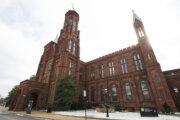WASHINGTON — Forty-seven years ago today, Apollo 11 landed on the Moon carrying astronauts Neil Armstrong and Buzz Aldrin and it became a place we had been to in our exploration of space. Ten more astronauts would return, and in December 1972, the Moon would go into a decades-long limbo.
That has changed. The Moon is undergoing a renaissance of exploration; it is no longer the Rodney Dangerfield of the solar system.
China, Russia, Europe, Japan, India, the U.S. and two private companies have slated missions to return to the Moon starting next year. China, Russia, Japan and Europe have said that they want to send humans to land on the Moon once again. My belief is that if they do so, they will not give up on the Moon as the U.S. did in 1972 but will have plans to stay — permanently.
The Moon may be the most valuable real estate in the solar system. Why? Location, location, location — it is currently only three days’ travel time from Earth and has a veritable bonanza of potential resources for use on the Moon and Earth.
The Moon has water in permanently shadowed craters located at its south pole, north pole and locked in its soil. There is abundant sunshine that is not hampered by weather and is available for harnessing for power by solar cells. Titanium, aluminum, potential nuclear fusion fuel HE-3 and the lunar soil itself are resources available for use in terraforming the Moon and someday, export to Earth.
Perhaps the most valuable location in the entire solar system is Shackleton Crater, at the lunar south pole, which has water and almost unlimited sunshine access. A lunar colony could thrive there due to the presence of water and sunlight. Lunar water could be used for drinking, breathing oxygen, growing crops and rocket fuel. Harnessed solar power from solar cells could terraform the lunar soil, power mining processes and the colony.
While NASA is committed to landing humans on Mars, the Moon is still part of NASA’s exploration, with both manned and unmanned missions. The Lunar Reconnaissance Orbiter is currently the only active lunar mission. NASA plans on sending unmanned Exploration Mission 1 out beyond the Moon in 2018 with a manned orbital mission to follow several years later. NASA has also recently discussed lunar colony plans.
The lessons learned on the Moon will help in the quest to land humans on Mars and colonize the Red Planet.
Forty years ago, NASA’s Viking 1 spacecraft touched down on Mars. The intrepid spacecraft became an orbiter and a laboratory by analyzing samples from trenches it had dug, sniffing the air and sending data back to Earth. NASA is celebrating Viking 1’s 40th anniversary in a big way with Live Stream events.
Tonight, take a look in the sky. Mars is bright in the south and the Moon beckons shortly after sunset. These are worlds we have been to and are striving to colonize one day. Humanity faces a lot of challenges here on Earth but our outward explorations define what is best in us and offer hope for a better future.
Learn more about space and the sky by joining me July 28-31 for the Night Sky Festival at Shenandoah National Park. These four days and nights will feature talks, telescopes and Astronaut Tom Jones. I hope to see you there!
Follow me on Twitter @skyguyinva and my daily blog to keep up with the latest news in astronomy and space exploration. You can email me at skyguyinva@gmail.com.







